SUPPLYING WATER TO THE PONDS
The characteristics of the water supply required for freshwater prawn farming have been discussed earlier in this manual. The topic of water supply is introduced in Muir and Lombardi (2000) and detailed in FAO (1981).
It is not normal to treat the water entering freshwater prawn ponds except to screen it to prevent entry of predators. Screening is not necessary where the water supply is piped from a well or a spring but is essential where surface water or open channel distribution is used. Well water requires aeration by cascading (Figure 50) or by supplying it above pond water level to re-establish gas equilibrium, as it is often initially very low in dissolved oxygen content. There are many alternative methods of screening. Crude screening excludes adults and fingerlings of unwanted species but not their eggs or larvae. Figure 51 shows a simple gravel filter which will exclude fish eggs and larvae as well. Water filtering devices are discussed in other FAO manuals (e.g. FAO 1992b, 1996).
The way in which water is distributed and supplied into freshwater prawn ponds is of great importance. Farms must be designed with a water distribution system that will allow the filling of one pond (or 10% of the pond surface area, whichever is the greater) at any time without starving the other ponds of replacement and flow-through water (Table 6).
There should not be any contact between incoming water and water drained from other ponds. Each pond should have its own individual supply from a central water distribution channel and should not receive the outflow from another pond (Figure 52). The trans-
FIGURE50
The dissolved oxygen levels of incoming pond water can be increased by rippling and cascading
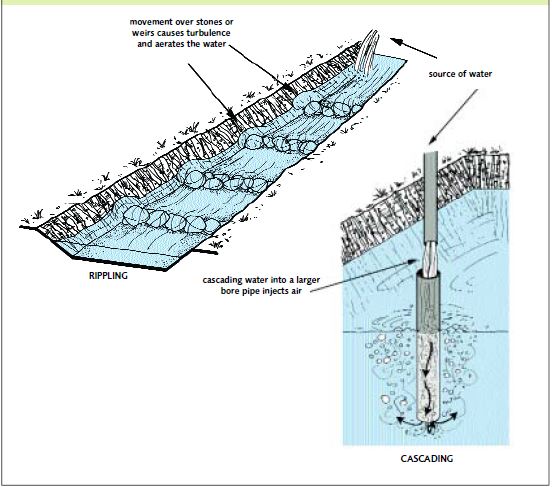
SOURCE: EMANUELA D’ANTONI
Figure 51
Simple gravel filters on the water intake system help to minimize the predators in freshwater prawn ponds (Peru)
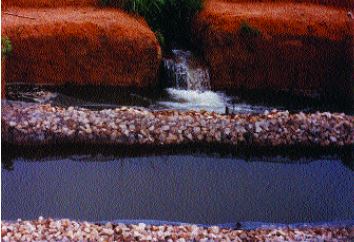
SOURCE: OSCAR ORBEGOSO MONTALVA
FIGURE52
Design your water distribution system so that each pond has a separate supply and the discharge from each pond does not enter any other
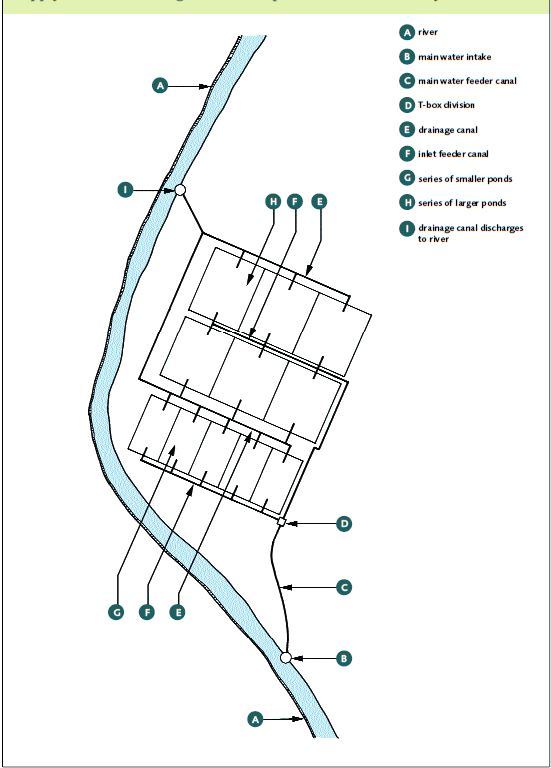
SOURCE: EMANUELA D’ANTONI, AFTER FAO (1992b)
Figure 53
Where the topography of the site makes it feasible, supplying water by gravity keeps the dissolved oxygen level high (Brazil)
Figure 54
Supplying water above the pond water level provides some oxygenation, while grass minimizes erosion of the bank (Brazil)
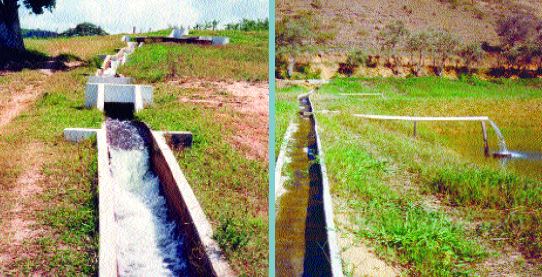
SOURCE: JULIO VICENTE LOMBARDI, REPRODUCED FROM NEW AND VALENTI (2000) WITH PERMISSION FROM BLACKWELL SCIENCE
fer of water from one pond to another is not recommended, because it means poorer water quality conditions in the second (and subsequent) ponds and brings the risk of disease transfer.
Ideally, water should be distributed in pipes or open channels by gravity if the topography of the site allows it (Figure 53). Similarly, inlet pipes or channels should be constructed above the water level in the ponds so that the incoming water falls onto the surface of the water (Figure 54). This may be achieved by pumping the water supply to an elevated channel, if this is economically feasible. The water inlet is normally placed at the shallow end of the pond, opposite the discharge point. The inlet channels (or pipes) and the outlet pipes must be correctly sized according to the water demand and draining needs of each pond.
Table 12 gives the water discharge capacity of concrete pipes under various pressure heads.
Detailed information on these topics is provided in other FAO manuals (FAO 1992b, 1995).
The flow of water into each pond must be controlled by valves, weirs, stop-logs or plugs (Figure 55). Detailed instructions on building these structures are given in FAO (1992b). While gravity supply, elevated water inlets and lack of cross-contamination of water between adjacent ponds represent the ideal, many freshwater prawn farms exist which do not comply with these recommendations. Many farms (due to site, technical, or
TABLE 12 Water discharge capacity (in m3/hr) of concrete pipes under various pressure heads

NOTE: THE WATER DISCHARGE CAPACITY OF PIPES INCREASES WITH THE PRESSURE HEAD (VERTICAL DISTANCE BETWEEN WATER SURFACE ABOVE AND CENTRE OF LINE OF PIPE BELOW).
SOURCE: DERIVED FROM FAO (1995)
FIGURE55
There are many different ways of controlling the water entering your ponds: these are some examples
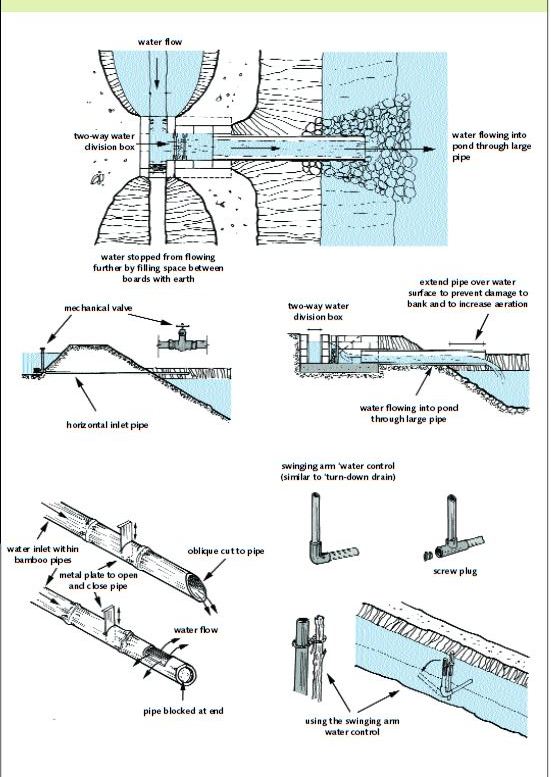
SOURCE: EMANUELA D’ANTONI, AFTER FAO (1992b)
financial limitations) have water inlets below the pond water level and receive water from an inlet channel (or a low-lying area such as paddy fields) with the same water level as the pond. In some cases ponds are directly interconnected. These farms produce freshwater prawns, often profitably. However, the use of such water supplies increases risk substantially; a proper water distribution system is essential for reliable high production.
Methods of minimizing water losses through seepage, by sealing ponds with organic matter, puddling, compaction, laying out a ‘soil blanket’, bentonite, or lining them with polyethylene, PVC, or butyl rubber sheeting are described in another FAO publication (FAO 1996).
Figure 56
The outlet structure, sometimes known as a ‘monk’, can be used to control the level of the water as well as to screen the water to prevent the loss of freshwater prawns (Brazil)
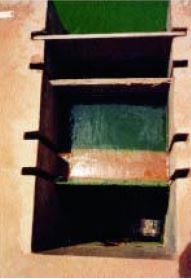
SOURCE: JULIO VICENTE LOMBARDI, REPRODUCED FROM NEW AND VALENTI (2000) WITH PERMISSION FROM BLACKWELL SCIENCE